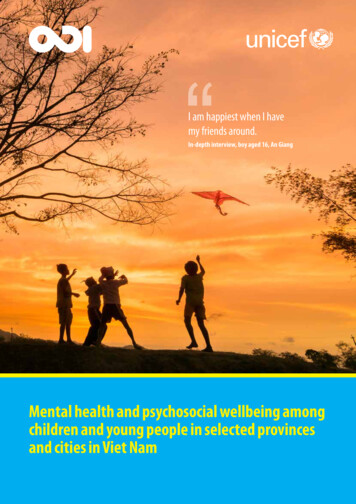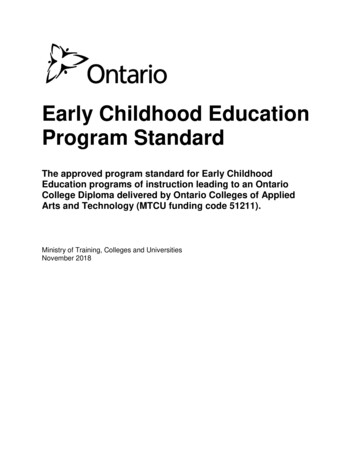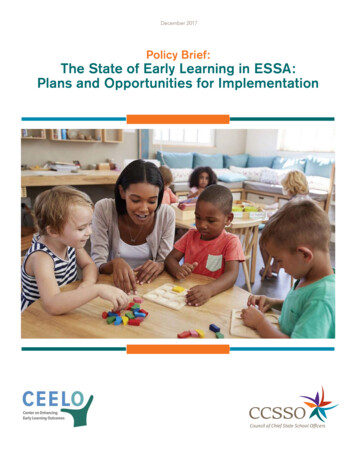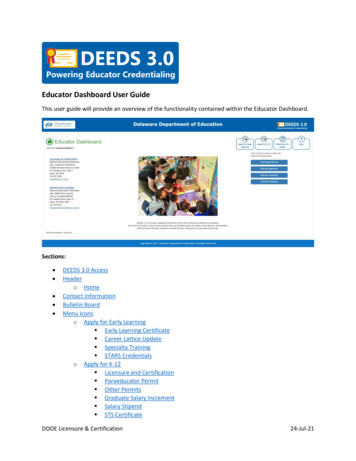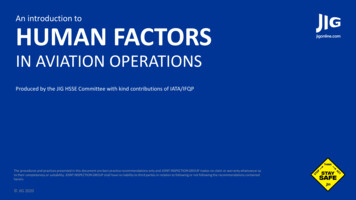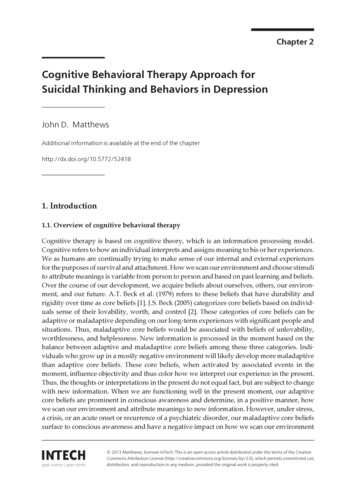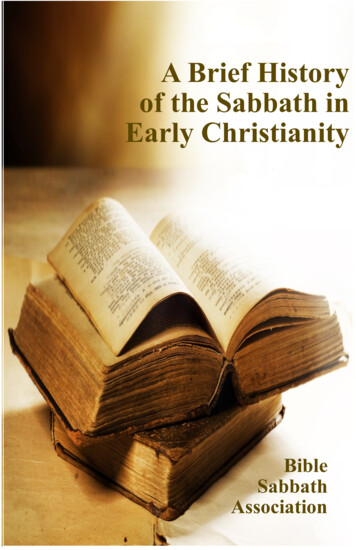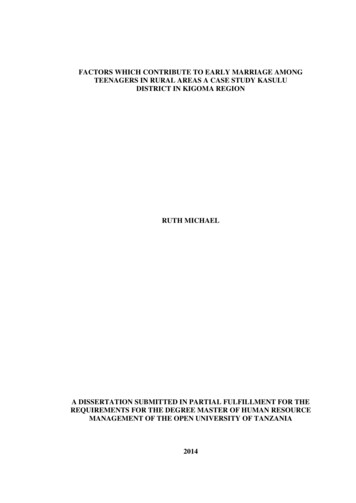
Transcription
FACTORS WHICH CONTRIBUTE TO EARLY MARRIAGE AMONGTEENAGERS IN RURAL AREAS A CASE STUDY KASULUDISTRICT IN KIGOMA REGIONRUTH MICHAELA DISSERTATION SUBMITTED IN PARTIAL FULFILLMENT FOR THEREQUIREMENTS FOR THE DEGREE MASTER OF HUMAN RESOURCEMANAGEMENT OF THE OPEN UNIVERSITY OF TANZANIA2014
iCERTIFICATIONI, the undersigned, certify that I have read and hereby recommend for acceptance by theOpen University of Tanzania a dissertation entitled Factors contribute to early marriageamong teenagers in rural areas in Kasulu District Council in Partial Fulfillment of therequirements for award of degree of Masters of Science in Human Resource Management ofOpen University of Tanzania.Date .Supervisor (Dr.Odas Bilame )
iiDECRALATIONI, Ruth Michael Kanyangu, declare that, this report is my original work and that ithas not been and will not be presented to any other University for similar or anyother degree award. Ruth Michael Date
iiiCOPYRIGHTNo part of this dissertation may be reproduced, stored in any retrieval system, ortransmitted in any form by any means, mechanical, photocopy, recording orotherwise without prior written permission of the author or the Open University ofTanzania in that behalf.
ivACKNOWLEDGEMENTResearch work is not an easy task to perform. It needs critical investigation whereby onemay come up with empirical findings to enable the affected population benefit from it. I amvery much indebted to all those who enthusiastically participated fully to support me.Special thanks should go directly to Dr. Odas Bilame my research supervisor who toiledmuch to ensure that my dissertation achieves academic qualities.Many thanks should go directly to Open University lecturers who gave knowledge and skillsto me on how to write dissertation especially through face to face program.It will be a crime if I forget to mention Mr.Rusambi who initially instructed us on howresearch procedures go on from the time of writing research proposal hence research report.Lastly may I thank the dearest mother of mine NaomyDaina, my beloved brothers Eric,Helbert, Nelvin, also my sisters Rosemary and Elita without forgetting my grandmother RuthSiswebe who also missed me when I was going on conducting this study hence to come upwith this scholarly material. Others are my friends Matindi, Mubarak, Mwajuma, Mr.Kundi,Beliz, Oscar, Tecla and Moshi who gave me a great support to complete this work.Succinctly, it is not easy to mention all those who made their contribution to my study, butthe only word I say, “The Almighty God may bless them!”
vDEDICATIONTo my beloved father Michael Kanyangu who passed away in 1995 as I promisedhim to study very hard and achieve my goals and he used to give me hope. Mayhis soul Rest In Peace.
viABSTRACTThe main objective of this study was to explore on factors contributing to earlymarriage among teenagers in rural areas in Kasulu District Council specificallyNyakitonto,Nyamnyusi,Buhoro and Nyachenda Wards.The methods used to get sample area which covered four wards of Kasulurural,Buhoro, Nyakitonto, Nyachenda and Nyamnyusi included cluster sampling.Simple random sampling was used to get 100 respondents who were female and malerepresenting others in these wards. Moreover purposive sampling was also used toget answers from District Executive Director and Ward Officers from the respectivewards under the sampled area.Research instruments used to collect data were questionnaires, interview guides andFocus Group Discussion (FGD) whereby girls, district council Officers and WardOfficers were contacted to get the reality.Then factors which contribute to early marriage among teenagers in rural areasrevealed to be; Inadequate sex education, Peer pressure, Conformity, Influence ofmass media, Lack of transparence, Shame, Traditional milestone, Unemploymentand Globalization.It is recommended that Government through the Ministry of health and socialwelfare and the ministry of Community development gender and children affairs mayconduct programmes in both rural and urban areas concerning early marriage andHIV/AIDS infections especially by addressing the factors which contribute to earlymarriage and also involving teenagers in decision making that can changecommunity mind set to abandon that practice.
viiTABLE OF CONTENTSCertification. iDecralation . iiCopyright . iiiAcknowledgement. ivDedication . vAbstract . viTable of Contents . viiList of Tables. xiList of Abbreviations. xiiCHAPTER ONE : INTRODUCTION . 11.1Background of the study . 11.2Statement of the problem . 61.3Research objectives . 81.3. 1 The general objective: . 81.3.2 Specific objectives: . 81.4Research hypothesis . 81.5Significance of the study . 101.6Limitation of the study . 101.7Study delimitation . 11CHAPTER TWO : LITERATURE REVIEW . 122.1Introduction . 122.1.1 Theoretical Literature review: . 142.1.1.1Socio-cultural and religious values . 14
viii2.1.1.1.1 Social feminist ideology: . 152.1.1.1.2 Religious values . 152.1.2 Emperical Literature review:. 152.1.2.1 Early marriage in Adolescent girls. 162.1.2.2Delaying Age of Marriage . 192.1.3 Research gap . 23CHAPTER THREE : RESEARCH METHODOLOGY . 243.1Introduction . 243.2Research Design . 243.3Study Area. 253.4Sources of Data . 253.4.1 Primary sources . 253.4.2 Secondary sources . 263.5Population . 273.6Sampling Techniques and Sample Size . 273.6.1 Sampling Techniques . 273.6.2 Sample Size . 283.7Data Collection. 313.7.1 Questionnaires . 313.7.2 Interviews . 323.8Data Analysis . 323.8.1 Data Analysis Plan . 333.8.2 Statistical Procedure . 333.9Ethical Consideration . 33
ix3.10Data Validity and Reliability . 34CHAPTER FOUR : RESEARCH FINDINGS AND DISCUSSION . 354.1Introduction . 354.2Results . 364.2.1 Social factors which contribute to early marriage among teenagers. 374.2.2 Cultural Factors contributing to early marriage . 384.2.3 Economic factors contributing to early marriage . 394.3Discussion . 404.3.1 Social factors contribute to early marriage among teenagers . 404.3.2 Cultural factors contribute to early marriage . 424.3.3 Economic factors contribute to early marriage . 434.3.4 Other Social and Cultural factors. . 44
xCHAPTER FIVE : SUMMARY, CONCLUSION, RECOMMENDATIONSAND AREAS FOR FURTHER RESEARCH . 465.1Summary . 465.2Conclusion . 475.3Recommendations . 495.4Areas for further research. 52REFERENCES . 53APPENDICES . 55
xiLIST OF TABLESTable 3.1 Socio-Demographic Characteristics of the sample by genderTable 4.1 Social factors contribute to early marriageTable 4.2 Cultural Factors contributing to early marriageTable 4.3 Economic factors contributing to early marriageTable 4.4 Other Social and Cultural factors
xiiLIST OF ABBREVIATIONSAIDSAcquired Immune Deficiency syndromeAYAAfrican Youth AllianceCBOsCommunity Based OrganizationsCDFChildren’s Dignity ForumDASDistrict Administrative SecretaryDHSDemographic and Health SurveyFGDsFocus Group DiscussionsHIVHuman Immunodeficiency VirusSTDsSexual Transmitted DiseasesSTIsSexual Transmitted InfectionsUNFPAUnited Nations Population FundUNICEFUnited Nations Children's FundURTUnited Republic of TanzaniaVEOVillage Executive OfficerWEOWard Executive Officer
1CHAPTER ONEINTRODUCTION1.1Background of the studyMarriage is a social institution that unites people in a special form of mutualdependence for the purpose of founding and maintaining a family. As a socialpractice entered into through a public act, religious or traditional ceremony, itreflects the purposes, character and customs of the society in which it is found. Manysocieties have norms that limit the age of young girls to enter into marriage, but insome cases the age limit does not take into consideration their physiologicalreadiness for childbearing. Marriage often takes place at ages much earlier than thelegally ratified minimum age. Early marriage is the marriage of children andadolescents below the age of 18 years.In several culture girls are forced to be married at a very early age due to variousreasons such as getting dowry, the fear of some parents that their daughters wouldget pregnant while at home.It was considered shameful for a girl to get pregnant outside wedlock. Other factorsinclude unequal power relations and economic hardship. This also exposes girls tounwanted pregnancies, sexually transmitted diseases including HIV/AIDS andabortions as common problems among adolescents worldwide. This also account asto why adolescents suffer more from related complications, such as maternal andinfant death.
2Early marriage put teenagers at risk because they are not fully physically developedto care for pregnancy, early marriage results in early and frequent child birth andsubsequently an increase in family size.Early marriage also denies girls the right to enjoy their childhood, the right toeducation and the right to a husband of her own choice and of her age. When younggirls are forced to marry someone who is older than herself and if it happens thathusband dies the chances of such girls to become a widow at an early age are high.But not only will that young mothers be left to take care the young children bythemselves.Because of bad customs and traditions, it is not guaranteed that these young wiveswill inherit their husband properties. Basically early marriages not only pose greaterhealth risks for the young mother and the baby, but it also violate the girls right tomake her own choice such customs must therefore be fought in all fronts.Laws determine the ages, sexes, physical conditions, and relations to mention but afew for both parties contracting marriage. Early marriage is used to refer both formalmarriage and informal unions in which a girl lives with a partner as if married beforeage of 18,Early marriage also known as child marriage is defined as “any marriagecarried out below the age of18 years before the girl is physically, physiologicallyready to shoulder the responsibilities of marriage and child bearing ”Child on theother hand, involves other one or both spouses being children and may take placewith or without formal registration and under civil religious or customary laws. We
3can trace the historical background to early by speculating the cultural context of themost of the people in the world.In most societies early marriage has been practiced from time immemorial. Thechildren used to be married after attaining puberty that is at around the age of 12 to16.This used to be the case for most of the girls who used to be given to men as oldas their fathers. The reason behind this is explained here after.The girls engage in marriage soon after their attainment to puberty in order to avoidsocial scandals. If the girl becomes pregnant at her father’s house, all blames go tofather or relatives.It was taken to be a curse if a girl remains at home after her puberty. So the familyhas to ensure that their daughters are getting husbands soon after the attainment ofthe age. The families often take pride in their daughters’ marriage.The family prestige depended on how many children their daughters bore for herhusband. The chance of bearing many children was secured as early as possible.Marriage of girls used to be a source of income to many families. This is how theparents used to pressurize their daughters to get married.As for boys getting married, it depended on the economic status of the families. Inrich families it was easy for a boy to secure a wife immediately after becoming ofage.
4With advent of awareness of human rights (especially women rights) womenemancipation and economic setbacks due to overpopulation, some kind ofrestrictions or control an early marriage started. Let us thrown right to what has beenhappening in Tanzania.During pre Colonial, Tanganyika used customary law in marriage. This of coursesupported early marriage as well as polygamy. The Arabs introduced Islamic religionin the context of Islam, where polygamy is allowed. The Germans arrived in the1880’s.Their Government accepted customary laws as regard to marriage.The British introduced the laws which restricted marriage to monogamy. Theyenacted other laws which regulated marriage and divorce for various groups such asthe Asians and Africans, Christians and non Christians.During independent Tanganyika, the 1963 local customary declaration order codifiedthe customary laws. However this did not change the Christian and Islamic marriagelaws. Customary laws were practiced mostly in rural area but not in urban areaswhere there were tribal mixtures.The Law recognizes both polygamy and monogamy. According to the Act a girl canget married at the age of 14 and above with the consent of her parents or guardians.Of course some amendments have been carried out on this Act in 1996, 1998, 1999and 2002 but there are still some controversies. These controversies arise due to
5cultural and religious differences, level of education and information accessibility aswell as psychological disposition of the people.Generally most girls become sexually active during adolescence. The rates arehighest in several countries of sub Sahara Africa where girls aged between 16 and 19are sexually active, thus leading millions of adolescents to have off-spring.In Latin America and Caribbean about one third of women population give birthbefore the age of 20.Likewise in Sub-Saharan Africa more than half of women givebirth before the age of 20.Early marriage and the subsequent forced marriages aredue to outdated customs, culture and taboos. Frankly speaking some tribal culturesand norms encourage girls’ involvement in prostitution at a tender age.In Tanzania incidences of early marriage and early pregnancies are prevalent in areassuch as Ruvuma, Mara, Mbeya, Singida, Arusha, Kilimanjaro, Dar es salaam,Morogoro, Lindi, Mtwara and Coastal Region.The other reasons that encourage the young girls to be involved in early marriage aresocio-economic pressure on the party of the parents. The latter force their children todrop out of school in order to earn a living on their own because they cannot takecare of them.In 1978 an Anglican Clergyman (priest) Thomas Mathus issued a paper onpopulation growth and its effects. In it he pointed out that while the population was
6increasing with giant steps, economic growth was in small steps. So there would beso many people while resources are limited. For him one of the courses forpopulation boom was early marriages. He praises the natural calamities such asfamine, floods and drought as blessings in disguise to man because they help to beatover population.1.2Statement of the problemDespite being prevalent with profound impacts, child marriage in Tanzania attractslimited attention yet it has become a serious problem in most parts of the countryparticularly in rural areas that is Nyakitonto, Nyachenda, Nyamnyusi and BuhoroMany girls especially with 14 and 15 years are forced into marriage by parents orguardians or relatives therefore they facing a lot of problems [Children DignityForum, 2010]. For instance, those young female who forced to enter into earlymarriage does not able to cope with marriage life, because their age does not allowthem to handle well the family matters. Adolescent mothers are also notable toreading the different gestures of their child such as illness, hunger, or pain. This putsboth the mother and the child in poor health. Child marriages also deny girls anopportunity for education and decision making.The parents\ guardians living in a poverty are often tempted to marry off their younggirls to obtains bride price in which they believe will relieve them from the economichardship, but in reality parents\ guardians are not familiar on the practice of younggirls marriage and their impact of their health and welfare of young females.
7Furthermore some society does not have a sufficient knowledge on the impact ofchild marriage that is why they are forcing their young girls to enter into earlymarriage. In reality, child marriage subjects a young girl to sexual activities at thetender age in which they are not physically mature, also young mothers face higherrisks during pregnancies including complications such as heavy bleeding, fistulainfection, anemia and enclampsia, which contribute to higher mortality rate of bothmother and a child [Children Dignity Forum, 2010].In Tanzania, the system of marriage as guided by Marriage Act [1971] containsloopholes that create ambiguity concerning of child marriages. For example, on theone hand it puts a limit on the acceptable age of marriage, while on the other hand itgives the parents the power of consent on marriage decisions. This was observedunder S. 13 of the Law of Marriage Act, which states that “no person shall marrywho, being male, has not attained the apparent age of eighteen years or beingfemale, has not attained the apparent age of fifteen years”.Hence a child marriage are usually legitimized by national laws, for instant [Marriage Act 1971] regardless of whether the child has an opportunity or is able togive full and informed consent, rendered many young girls to suffer severe physical,economic, biological, social and psychological problems, and also contravene severalinternational human rights instruments
81.3Research objectives1.3. 1 The general objective:The general objective of this proposed study was to investigate about social, culturaland economic factors contributing to early marriage among teenagers in KasuluDistrict Council.1.3.2Specific objectives:The specific Objective of this proposed study were:i) To examine social factors contributing to early marriage among teenagers inKasuludistrict Council.ii) To analyze cultural factors contributing to early marriage among teenagers.iii) To explore economic factors contributing to early marriage among teenagers.1.4Research hypothesisH1 There was significant relationship between social factors and early marriageamong teenagers. To test this, the following variables were used. Inadequate sex education. Inadequate social control in sexual matters. The distance between parents and children. Peer pressure. Environment influences. Conformity. Prejudice Parents conflicts
9 Frustration. Influence of mass media.H2 There was significant relationship between cultural related factors and earlymarriage among teenagers in Kasulu District Council.To test this, the following variables were studied; Lack of Transparence. Negative attitude on Contraceptive. Shame or shyness. Lack of access to information. Inadequate parental care. Inadequate socialization in family and community. Traditional milestones.H3 There was significant relationship between economic related factors and earlymarriage among teenagers.To test these following variables were studied Meager economic resource. Unemployment Prostitution Globalization Lack of Credit facilities.
101.5 Significance of the studyThe findings of this study and recommendations are an eye opener to parents to helpthem abandon early marriage among young girls. The findings help the Ministryconcerned to come out with proper policy strategies to overcome the problem. Theresearch also is adding new knowledge on the existing one on early marriage amongyoung girls.1.6Limitation of the studyThere are some hurdles which attempted to hinder this study to be conductedeffectively, these were:-ResourcesFinancial ResourcesFinancial resources were the major obstacle to make the study to be easilyimplemented. The researcher was self – sponsored, and thus depended upon hismeager salary.Time ResourceThe time required to accomplish the research work was too short and this made theresearcher to focus on only one district in order to meet the time allocated.Job Roles and ResponsibilitiesA researcher is a Divisional Officer and at the same time a student of MSC-HRM atthe Open University of Tanzania. When conducting research and writing dissertation
11she was also supposed to perform her daily responsibilities which poses a lot ofchallenges to her.IlliteracySome of the respondents may have proper information about the study but they hideit because they do not understand the importance of the exercise.1.7Study delimitationThe study were carried out in Kigoma region at Kasulu District specifically in fivewards of Kasulu rural which are Nyakitonto, Buhoro, Nyachenda, Kitagata andNyamnyusi .
12CHAPTER TWOLITERATURE REVIEW2.1IntroductionThis chapter presents the reviewed literature from other scholars and researchersrelated to this Study of the factor which contribute to early marriage among teenagersin rural areas.The term “literature” refers to the analysis of text books or manuscripts. Althoughmany people rightly associate literature with novels and poetry (fiction), in researchthe term is more specific. In terms of a literature review, the term literature (non –fiction) means the works the researcher consulted in order to understand andinvestigate the research problem.A literature review therefore is an account of what has been published on a topic byaccredited, scholars and researchers. It is a critical look at the existing research that issignificant to the work that the researcher will be carrying out. It involves examiningdocument such as, books, magazine journals and dissertation that have a bearing onthe study being conducted.Conceptual FrameworkThe Law of the child Act 2009 defines a child to be a person below the age ofeighteen under section 13. The law of the Child Act is a supreme law for theprotection of children rights, however it was violated by several legislations because
13the definition of child in Tanzania is not inimitable. In Tanzania the definition of achild is provided diversely according to the context and purpose that certain statutesseek to achieve.For instance, the Employment and Labour Relations Act (2004) defines a “child” asa person under the age of 14 years; provided that for the employment of hazardoussectors, a child means a person under the age of 18 years.In addition, the Law of Marriage Act of 1971 under Section 2(1) defines a child as“who has not attained the age of 18 years” and the same statute under Section 13(1),permits marriage of young girls who have attained 15 years with consent of parentsand court. But section 4(1) of the Law of child Act resembles with InternationalInstruments that is:Article 1 of the United Nations Convention on the Rights and Welfare of the Child of[1989] defines a child as “every human being below the age of 18 years”. AlsoArticle 2 of the African Charter on the Rights and Welfare of the Child of [1990]states that “For the purpose of this Charter, a child means a human being below theage of 18 years” The actual meaning of the articles was that, the child should beprotected at least up to the age of 18.Thus why the articles of the Conventionsremained relatively open. Furthermore Article 24 of the ICCPR( 1966) recognizesthe right of every child, without any discrimination, to receive from his/her family,society and the state the protection required by his or her status as “a minor” So it isinternationally recognized that children are those human beings below 18 years old.
14For the purpose of this research this is the concept which is adopted for the meaningof early marriage. Basically early marriage can also be regarded as forced marriagebecause it is conducted without a valid consent of one or both sides.2.1.1 Theoretical Literature review:A theoretical frame work is a collection interrelated ideas based on theories. It is areasoned set of proposition, which are derived from and supported by data or evidence.A theoretical framework accounts for or explains phenomena. It attempts to clarifywhy things are the way they are based on theories. A theoretical framework is ageneral set of assumptions about the nature of phenomena. (Kombo and Tromp,2006:56)2.1.1.1 Socio-cultural and religious valuesIn communities where child marriage is prevalent, there is strong social pressure onfamilies to conform. Failure to conform can often result in ridicule, disapproval orfamily shame. Invariably, local perceptions on the ideal age for marriage, the desirefor submissive wives, extended family patterns and other customary requirements,are all enshrined in local customs or religious norms. In many contexts childmarriage is legitimized by patriarchy, and related family structures, which ensure thatmarriage transfers a father’s ro
marriage and informal unions in which a girl lives with a partner as if married before age of 18,Early marriage also known as child marriage is defined as "any marriage carried out below the age of18 years before the girl is physically, physiologically ready to shoulder the responsibilities of marriage and child bearing "Child on the

